Rajat Talak
Box Pose and Shape Estimation and Domain Adaptation for Large-Scale Warehouse Automation
Jul 01, 2025Abstract:Modern warehouse automation systems rely on fleets of intelligent robots that generate vast amounts of data -- most of which remains unannotated. This paper develops a self-supervised domain adaptation pipeline that leverages real-world, unlabeled data to improve perception models without requiring manual annotations. Our work focuses specifically on estimating the pose and shape of boxes and presents a correct-and-certify pipeline for self-supervised box pose and shape estimation. We extensively evaluate our approach across a range of simulated and real industrial settings, including adaptation to a large-scale real-world dataset of 50,000 images. The self-supervised model significantly outperforms models trained solely in simulation and shows substantial improvements over a zero-shot 3D bounding box estimation baseline.
Language-Grounded Hierarchical Planning and Execution with Multi-Robot 3D Scene Graphs
Jun 09, 2025Abstract:In this paper, we introduce a multi-robot system that integrates mapping, localization, and task and motion planning (TAMP) enabled by 3D scene graphs to execute complex instructions expressed in natural language. Our system builds a shared 3D scene graph incorporating an open-set object-based map, which is leveraged for multi-robot 3D scene graph fusion. This representation supports real-time, view-invariant relocalization (via the object-based map) and planning (via the 3D scene graph), allowing a team of robots to reason about their surroundings and execute complex tasks. Additionally, we introduce a planning approach that translates operator intent into Planning Domain Definition Language (PDDL) goals using a Large Language Model (LLM) by leveraging context from the shared 3D scene graph and robot capabilities. We provide an experimental assessment of the performance of our system on real-world tasks in large-scale, outdoor environments.
Outlier-Robust Training of Machine Learning Models
Dec 31, 2024Abstract:Robust training of machine learning models in the presence of outliers has garnered attention across various domains. The use of robust losses is a popular approach and is known to mitigate the impact of outliers. We bring to light two literatures that have diverged in their ways of designing robust losses: one using M-estimation, which is popular in robotics and computer vision, and another using a risk-minimization framework, which is popular in deep learning. We first show that a simple modification of the Black-Rangarajan duality provides a unifying view. The modified duality brings out a definition of a robust loss kernel $\sigma$ that is satisfied by robust losses in both the literatures. Secondly, using the modified duality, we propose an Adaptive Alternation Algorithm (AAA) for training machine learning models with outliers. The algorithm iteratively trains the model by using a weighted version of the non-robust loss, while updating the weights at each iteration. The algorithm is augmented with a novel parameter update rule by interpreting the weights as inlier probabilities, and obviates the need for complex parameter tuning. Thirdly, we investigate convergence of the adaptive alternation algorithm to outlier-free optima. Considering arbitrary outliers (i.e., with no distributional assumption on the outliers), we show that the use of robust loss kernels {\sigma} increases the region of convergence. We experimentally show the efficacy of our algorithm on regression, classification, and neural scene reconstruction problems. We release our implementation code: https://github.com/MIT-SPARK/ORT.
CRISP: Object Pose and Shape Estimation with Test-Time Adaptation
Dec 02, 2024Abstract:We consider the problem of estimating object pose and shape from an RGB-D image. Our first contribution is to introduce CRISP, a category-agnostic object pose and shape estimation pipeline. The pipeline implements an encoder-decoder model for shape estimation. It uses FiLM-conditioning for implicit shape reconstruction and a DPT-based network for estimating pose-normalized points for pose estimation. As a second contribution, we propose an optimization-based pose and shape corrector that can correct estimation errors caused by a domain gap. Observing that the shape decoder is well behaved in the convex hull of known shapes, we approximate the shape decoder with an active shape model, and show that this reduces the shape correction problem to a constrained linear least squares problem, which can be solved efficiently by an interior point algorithm. Third, we introduce a self-training pipeline to perform self-supervised domain adaptation of CRISP. The self-training is based on a correct-and-certify approach, which leverages the corrector to generate pseudo-labels at test time, and uses them to self-train CRISP. We demonstrate CRISP (and the self-training) on YCBV, SPE3R, and NOCS datasets. CRISP shows high performance on all the datasets. Moreover, our self-training is capable of bridging a large domain gap. Finally, CRISP also shows an ability to generalize to unseen objects. Code and pre-trained models will be available on https://web.mit.edu/sparklab/research/crisp_object_pose_shape/.
Test-Time Certifiable Self-Supervision to Bridge the Sim2Real Gap in Event-Based Satellite Pose Estimation
Sep 10, 2024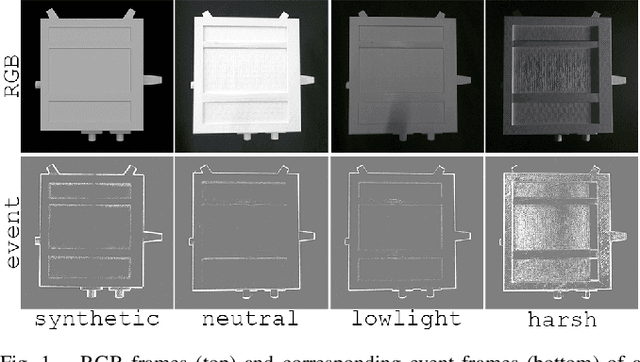
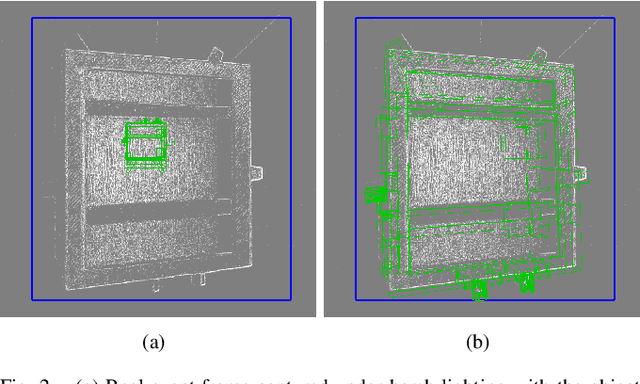

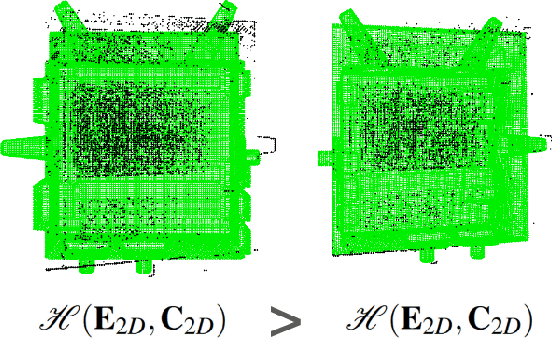
Abstract:Deep learning plays a critical role in vision-based satellite pose estimation. However, the scarcity of real data from the space environment means that deep models need to be trained using synthetic data, which raises the Sim2Real domain gap problem. A major cause of the Sim2Real gap are novel lighting conditions encountered during test time. Event sensors have been shown to provide some robustness against lighting variations in vision-based pose estimation. However, challenging lighting conditions due to strong directional light can still cause undesirable effects in the output of commercial off-the-shelf event sensors, such as noisy/spurious events and inhomogeneous event densities on the object. Such effects are non-trivial to simulate in software, thus leading to Sim2Real gap in the event domain. To close the Sim2Real gap in event-based satellite pose estimation, the paper proposes a test-time self-supervision scheme with a certifier module. Self-supervision is enabled by an optimisation routine that aligns a dense point cloud of the predicted satellite pose with the event data to attempt to rectify the inaccurately estimated pose. The certifier attempts to verify the corrected pose, and only certified test-time inputs are backpropagated via implicit differentiation to refine the predicted landmarks, thus improving the pose estimates and closing the Sim2Real gap. Results show that the our method outperforms established test-time adaptation schemes.
Safe Distributed Control of Multi-Robot Systems with Communication Delays
Feb 14, 2024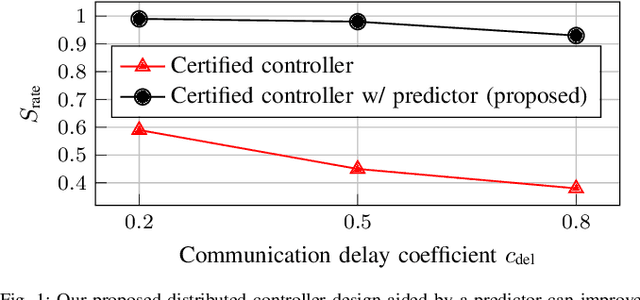
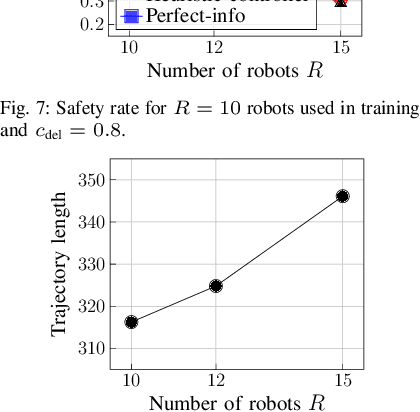


Abstract:Safe operation of multi-robot systems is critical, especially in communication-degraded environments such as underwater for seabed mapping, underground caves for navigation, and in extraterrestrial missions for assembly and construction. We address safety of networked autonomous systems where the information exchanged between robots incurs communication delays. We formalize a notion of distributed control barrier function (CBF) for multi-robot systems, a safety certificate amenable to a distributed implementation, which provides formal ground to using graph neural networks to learn safe distributed controllers. Further, we observe that learning a distributed controller ignoring delays can severely degrade safety. Our main contribution is a predictor-based framework to train a safe distributed controller under communication delays, where the current state of nearby robots is predicted from received data and age-of-information. Numerical experiments on multi-robot collision avoidance show that our predictor-based approach can significantly improve the safety of a learned distributed controller under communication delays
Foundations of Spatial Perception for Robotics: Hierarchical Representations and Real-time Systems
May 11, 2023Abstract:3D spatial perception is the problem of building and maintaining an actionable and persistent representation of the environment in real-time using sensor data and prior knowledge. Despite the fast-paced progress in robot perception, most existing methods either build purely geometric maps (as in traditional SLAM) or flat metric-semantic maps that do not scale to large environments or large dictionaries of semantic labels. The first part of this paper is concerned with representations: we show that scalable representations for spatial perception need to be hierarchical in nature. Hierarchical representations are efficient to store, and lead to layered graphs with small treewidth, which enable provably efficient inference. We then introduce an example of hierarchical representation for indoor environments, namely a 3D scene graph, and discuss its structure and properties. The second part of the paper focuses on algorithms to incrementally construct a 3D scene graph as the robot explores the environment. Our algorithms combine 3D geometry, topology (to cluster the places into rooms), and geometric deep learning (e.g., to classify the type of rooms the robot is moving across). The third part of the paper focuses on algorithms to maintain and correct 3D scene graphs during long-term operation. We propose hierarchical descriptors for loop closure detection and describe how to correct a scene graph in response to loop closures, by solving a 3D scene graph optimization problem. We conclude the paper by combining the proposed perception algorithms into Hydra, a real-time spatial perception system that builds a 3D scene graph from visual-inertial data in real-time. We showcase Hydra's performance in photo-realistic simulations and real data collected by a Clearpath Jackal robots and a Unitree A1 robot. We release an open-source implementation of Hydra at https://github.com/MIT-SPARK/Hydra.
A Correct-and-Certify Approach to Self-Supervise Object Pose Estimators via Ensemble Self-Training
Feb 12, 2023



Abstract:Real-world robotics applications demand object pose estimation methods that work reliably across a variety of scenarios. Modern learning-based approaches require large labeled datasets and tend to perform poorly outside the training domain. Our first contribution is to develop a robust corrector module that corrects pose estimates using depth information, thus enabling existing methods to better generalize to new test domains; the corrector operates on semantic keypoints (but is also applicable to other pose estimators) and is fully differentiable. Our second contribution is an ensemble self-training approach that simultaneously trains multiple pose estimators in a self-supervised manner. Our ensemble self-training architecture uses the robust corrector to refine the output of each pose estimator; then, it evaluates the quality of the outputs using observable correctness certificates; finally, it uses the observably correct outputs for further training, without requiring external supervision. As an additional contribution, we propose small improvements to a regression-based keypoint detection architecture, to enhance its robustness to outliers; these improvements include a robust pooling scheme and a robust centroid computation. Experiments on the YCBV and TLESS datasets show the proposed ensemble self-training outperforms fully supervised baselines while not requiring 3D annotations on real data.
PyPose: A Library for Robot Learning with Physics-based Optimization
Sep 30, 2022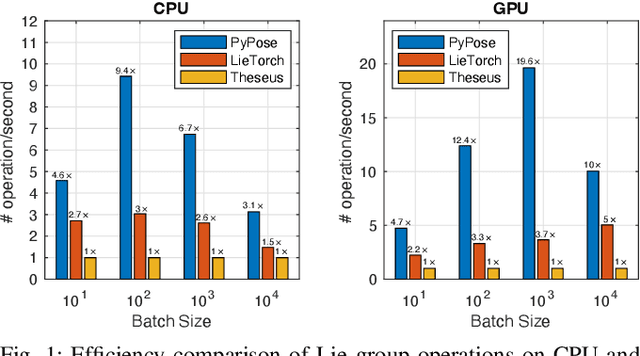
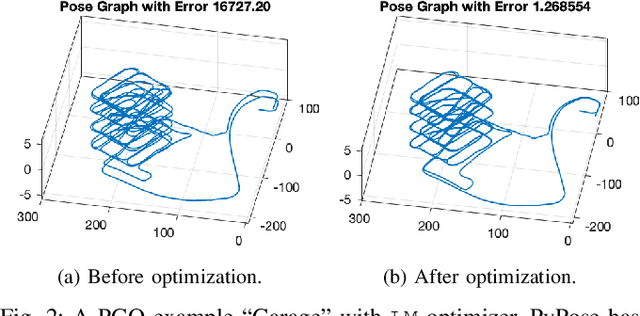
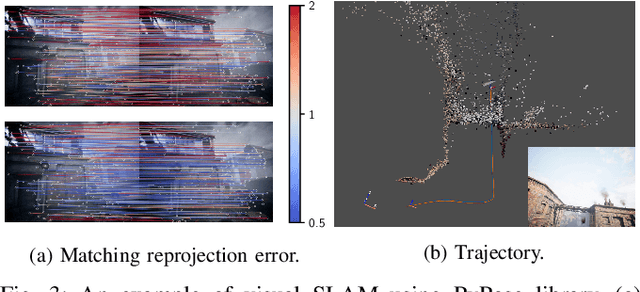
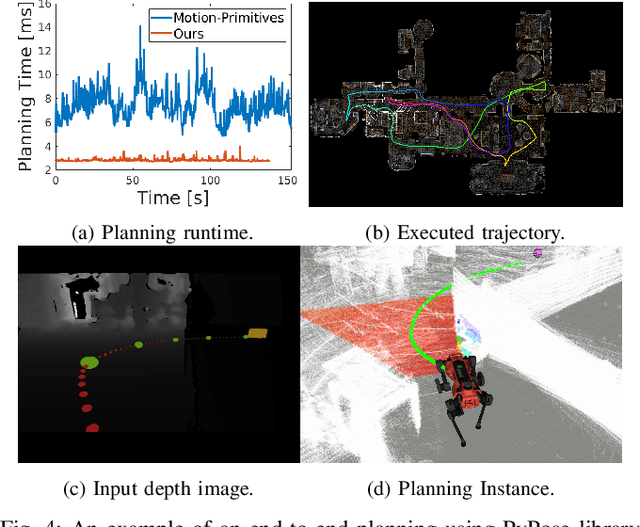
Abstract:Deep learning has had remarkable success in robotic perception, but its data-centric nature suffers when it comes to generalizing to ever-changing environments. By contrast, physics-based optimization generalizes better, but it does not perform as well in complicated tasks due to the lack of high-level semantic information and the reliance on manual parametric tuning. To take advantage of these two complementary worlds, we present PyPose: a robotics-oriented, PyTorch-based library that combines deep perceptual models with physics-based optimization techniques. Our design goal for PyPose is to make it user-friendly, efficient, and interpretable with a tidy and well-organized architecture. Using an imperative style interface, it can be easily integrated into real-world robotic applications. Besides, it supports parallel computing of any order gradients of Lie groups and Lie algebras and $2^{\text{nd}}$-order optimizers, such as trust region methods. Experiments show that PyPose achieves 3-20$\times$ speedup in computation compared to state-of-the-art libraries. To boost future research, we provide concrete examples across several fields of robotics, including SLAM, inertial navigation, planning, and control.
Leveraging Large Language Models for Robot 3D Scene Understanding
Sep 12, 2022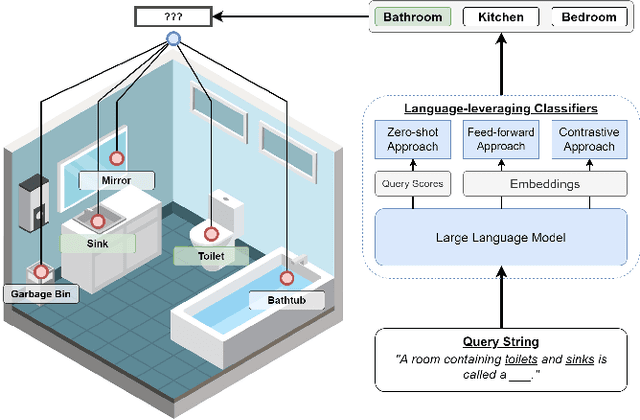

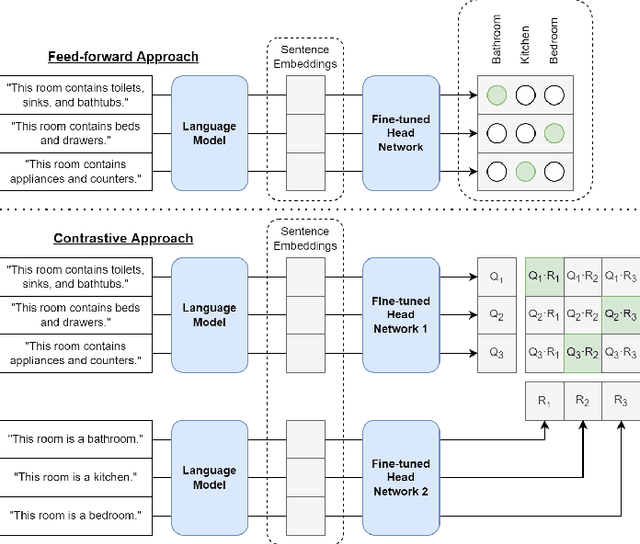
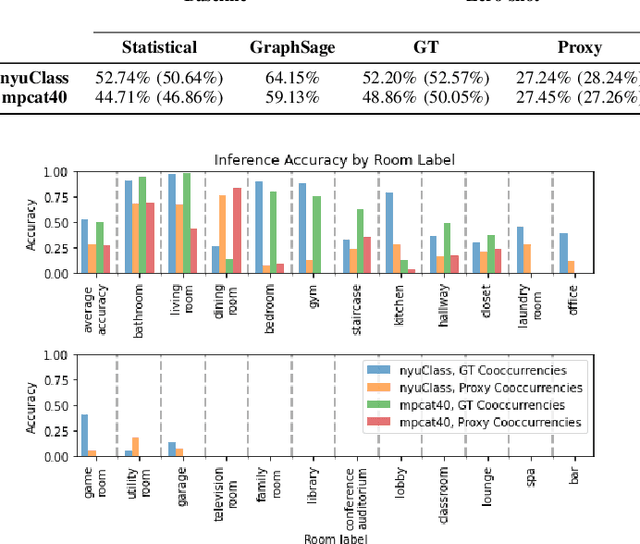
Abstract:Semantic 3D scene understanding is a problem of critical importance in robotics. While significant advances have been made in spatial perception, robots are still far from having the common-sense knowledge about household objects and locations of an average human. We thus investigate the use of large language models to impart common sense for scene understanding. Specifically, we introduce three paradigms for leveraging language for classifying rooms in indoor environments based on their contained objects: (i) a zero-shot approach, (ii) a feed-forward classifier approach, and (iii) a contrastive classifier approach. These methods operate on 3D scene graphs produced by modern spatial perception systems. We then analyze each approach, demonstrating notable zero-shot generalization and transfer capabilities stemming from their use of language. Finally, we show these approaches also apply to inferring building labels from contained rooms and demonstrate our zero-shot approach on a real environment. All code can be found at https://github.com/MIT-SPARK/llm_scene_understanding.
 Add to Chrome
Add to Chrome Add to Firefox
Add to Firefox Add to Edge
Add to Edge